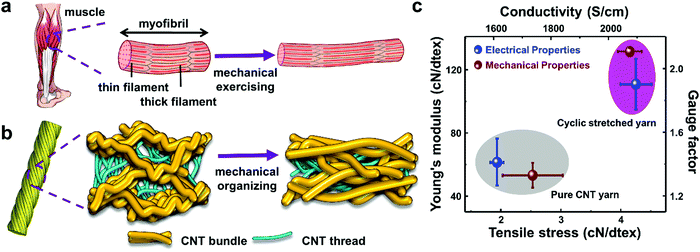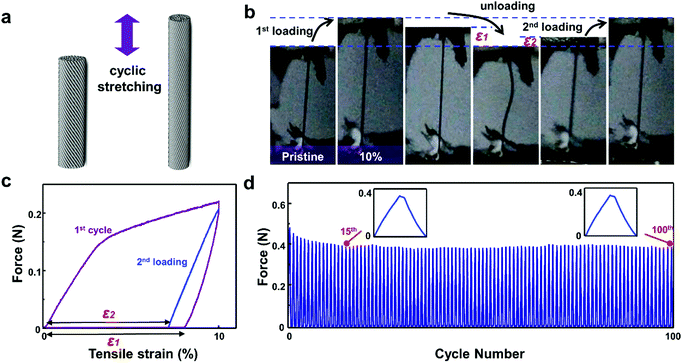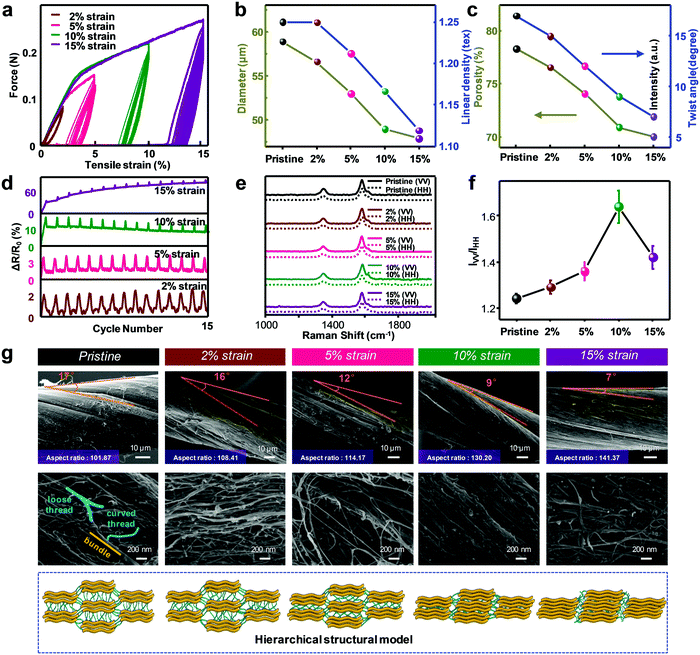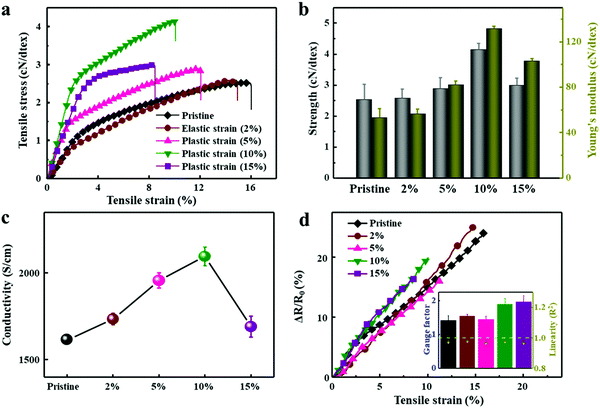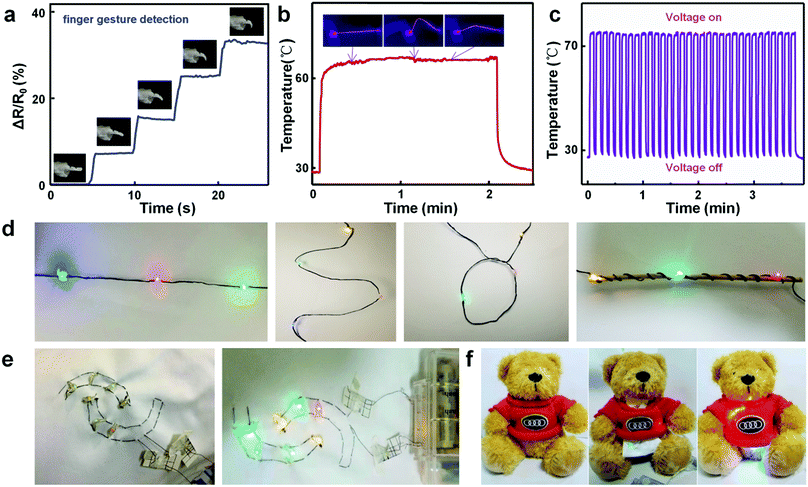Bioinspired microstructure-reorganized behavior of carbon nanotube yarn induced by cyclic stretching training†
Zhiyong
Wang
a,
Jianhua
Wu
a,
Xiaoxiao
Wei
ab,
Sidra
Saleemi
a,
Wei
Liu
c,
Wei
Li
a,
Ifra
Marriam
 a and
Fujun
Xu
a and
Fujun
Xu
 *ab
*ab
aCollege of Textiles, Donghua University, Shanghai 201620, P. R. China. E-mail: fjxu@dhu.edu.cn
bState Key Laboratory for Modification of Chemical Fibers and Polymer Materials, Donghua University, Shanghai 201620, P. R. China
cCollege of Fashion Technology, Shanghai University of Engineering Science, Shanghai 201620, P. R. China
First published on 22nd November 2019
Abstract
Microstructure-reorganized behavior is where the microstructure of a material can be reorganized under some conditions, such as temperature or moisture changes, electrical or mechanical stimulation. Human muscle, comprising an exceptional hierarchical structure, is a representative example whose flexibility and strength can be enhanced remarkably after cyclic stretching training owing to the mechanically reorganized structural arrangement and redistribution (alignment and elongation). The hierarchical structure (bundles and threads) of the yarn, which is similar to that (thick and thin filaments) of human muscle, can also be microstructure-reorganized. Herein, bioinspired by the structure-reorganized behavior of muscle, for the first time, a novel strain engineering strategy (cyclic stretching or cyclic loading) is adopted to tune the hierarchical structure and properties of CNT yarns. By applying an optimized tensile strain (10%) for cyclic stretching, the CNT yarn exhibits much enhanced mechanical and electrical properties of tensile strength (+64%), Young's modulus (+148%), conductivity (+30%) and piezo-resistive sensitivity (+35%), as compared with pristine CNT yarn. Moreover, a comprehensive structural mechanism is proposed and confirmed to interpret the microstructure-reorganized mechanism. The microstructure-reorganized CNT yarn can be generally applied in advanced wearable textiles, flexible electronics and multifunctional composites with much improved mechanical and electrical performance especially, under cyclic loading conditions.
1. Introduction
For several decades, carbon nanotubes (CNTs) have been famous for their excellent mechanical,1 electrical2 and thermal properties.3 However, when assembled as films or yarns, these properties cannot be fully realized as theoretically described owing to their loose network structure and the weak interaction between individual CNTs.4,5 Hence, to improve their prospects for applications (e.g., artificial muscles,6 energy devices,7–9 intelligent textiles10 and engineered composites),11,12 the development of high-performance CNT yarns with improved properties is essential.Recently, various strategies, such as mechanical twisting,13 polymer infiltration,14 irradiation treatment,15,16 annealing17 and solvent densification,18,19 have been proposed to enhance the properties of CNT yarns. In mechanical twisting, applying an appropriate twist to the CNT yarn can make the structure densified and oriented, whereas over twisting can result in a sharp decrease of the mechanical modulus and even the strength of the CNT yarn.13 Besides, polymer infiltration is another modified method that has an excellent positive effect on the enhancement of the yarn's stress and modulus. Unfortunately, the polymer infiltration process and the resulting composite properties are hard to control.14 Furthermore, irradiation treatment,15,16 annealing17 (remove impurities), solvent densification18 (affinity effect) and chemical solvent treatment19 have also been proposed to improve the mechanical or electrical properties of CNT yarn or film. However, the energy consumption and environmental hazards of the above-discussed strategies limit their use in large-scale fabrication and practical applications (e.g., non-invasive and wearable healthcare).20
It is well-known that human muscle, possessing a network structure consisting of thick (myosin) and thin (actin) filaments, can be strengthened after repeated exercise owing to training-induced alignment.21,22 Currently, this viable engineering approach has been primarily applied for improving the mechanical performance of materials like polymers and hydrogels.22–24 Song et al. demonstrated that ultra-strong elastomers (uEs) could be obtained after cyclic tension deformation owing to the microstructure rearrangement of the crystalline and amorphous regions in P(UDA-co-BUDA) copolymers.23 Additionally, Lin et al. proposed a novel strategy of mechanical training (repeated pre-stretch) to make the nanofibrils in polyvinyl alcohol (PVA) hydrogel more aligned, attributing the facile structure adjustment containing nanocrystalline domain and amorphous chains.24 However, these materials are inherently not conductive. Central to improving both mechanical and electrical properties via cyclic stretching is the exploitation of materials possessing intrinsic conductivity, muscle-like hierarchical structure and appropriate plastic deformation. Thereby, CNT yarn, which is exceptional for its hierarchical network containing axial bundles and transverse threads,25 is a suitable material for enhancing its mechanical and electrical performance through the cyclic stretching process, without additional chemical modification and additives.
In this work, microstructure-reorganized behavior is induced by a muscle-inspired strategy of mechanical training (cyclic stretching), which substantially enhances the mechanical strength, Young's modulus, electrical conductivity, and piezoresistive sensitivity of the CNT yarn. This process is further investigated with different extents of cyclic stretching. Simultaneously, the microstructure-reorganized mechanism is demonstrated by the comprehensive hierarchical structural mechanism. This biomimetic strategy, which is capable of improving both the mechanical and electrical performance of the CNT yarn, opens a new avenue for practical applications, especially under cyclic loading conditions.
2. Experimental section
2.1. Specimen preparation
Continuous CNT yarns were prepared using an aerogel spinning method involving chemical vapor deposition (CVD) in a vertical furnace at 1200 °C, provided by the Suzhou Institute of Nano-Tech and Nano-Bionics, Chinese Academy of Sciences. The multi-walled CNTs in the CNT yarn had about 10 walls with a diameter of approximately 25 nm. The CNT yarn was measured to be 0.25 mg with 20 cm length and the average linear density was 1.25 μg mm−1 or 1.25 tex. In order to prepare the cyclic stretching specimens, CNT yarns were clamped in a straight line in the middle of the cardboard with a 6 mm gauge length.2.2. Characterization
The tensile strength of the CNT yarns was tested using an XQ-2 testing machine (Shanghai Xusai Instrument Co., China). Four typical strain parameters (2% elastic region, 5% primary plastic region, 10% middle plastic region and 15% latter plastic region) were selected to carry out the cyclic stretching process with 6 mm gauge length, 1 mm min−1 speed, no elongation time and no recovery time. The electrical properties were tested using a multi-meter (Agilent 34410A, USA) with a two-probe method. Notably, the electrical conductivity was determined by four-probe measurement. The structural changes before and after cyclic stretching were substantiated by field emission scanning electron microscopy (FESEM, Hitachi S4800. and 5 kV), scanning electron microscopy (SEM, Hitachi TM3000 at 5 kV) and Raman spectroscopy (Renishaw in Via Raman microscope, 633 nm).3. Results and discussion
The hierarchical structure of the human medial gastrocnemius muscle, as shown in Fig. 1a, is based on thick and thin filaments. When exposed to cyclic stretching, the muscle structure can be reorganized to a more compact and ordered form, which results in better mechanical (flexibility and strength) performance with better training-induced alignment.21,22 To mimic the above-mentioned unique behavior of human muscle, the novel strategy of cyclic stretching straining is adopted to modify both the mechanical and electrical properties of the CNT yarn. Specifically, the hierarchical structure (bundles and threads) endows the CNT yarn with the capability to achieve structural reorganization, which is extremely similar to the structure of human muscle. Fig. 1b illustrates schematically the elaborate microstructure-reorganized process for CNT yarn induced by appropriate cyclic loading conditions. To practically analyze the microstructure-reorganized behavior of the cyclic stretching process, CNT yarns were clamped straight on the cardboard with a 6 mm gauge length26 (as shown in Fig. S1, ESI†) to undergo cyclic stretching with different strains: elastic region (2%), primary plastic region (5%), middle plastic region (10%) and latter plastic region (15%) (as shown in Fig. S2, ESI†). Consequently, the experimental results showed that the CNT yarn after cyclic stretching under optical tensile strain (10% strain) with 15 cycles exhibits maximum mechanical and electrical performance (tensile strength (+64%), Young's modulus (+148%), conductivity (+30%) and piezoresistive sensitivity (+35%)), as presented in Fig. 1c.As mentioned above, human medial gastrocnemius muscle will be more oriented and denser after cyclic stretching training, and thus stronger than before. Notably, the hierarchical structure of the CNT yarn has many similarities with that of human muscle. The self-adjustment capability of the threads and bundles of the CNT yarn enables cyclic stretching training (Fig. 1b) to be efficient enough to enhance both the mechanical and electrical properties. Fig. 2a illustrates schematically the cyclic stretching behavior of the CNT yarn. Based on the elaborate observation and the corresponding typical mechanical force to strain curve of this process (as shown in Fig. 2b and c), we can easily understand the cyclic stretching behavior of the CNT yarn (e.g. 10% strain). Obviously, irreversible deformation can be caused directly by the first strain cycle. Subsequently, no force is applied during the ε1 stage of the first unloading process and the ε2 stage of the second loading process of the CNT yarn. It is worth noting that the second loading subjects force earlier than the first unloading point, which suggests that microstructure-reorganized behavior happens. Notably, the strategy of cyclic stretching training is very different from the single drawing approach. We repeatedly stretched CNT yarn at 10% strain for 15 times, whose breaking stress and sensitivity were better than the CNT yarn singly drew to 10% strain (Fig. S3a, ESI†). This is due to the adjustment of the yarn's internal porosity and cracks during cyclic stretching (Fig. S3b, ESI†), as exhibited in previous research.27–29 Actually, another structure arrangement strategy, applying single drawing and then maintaining for a while to CNT yarn, is a process of creep. A larger strain needs to be applied for the purpose of obvious modification, and the time of maintenance is difficult to control. Most importantly, single drawing will result in a non-uniform structure change, so it cannot contribute much to the gauge factor, while cyclic stretching is a more temperate and effective strategy. After several cycles of training, the structure of the CNT yarn will be more uniform and compact, as well as having good alignment. Fig. 2d displays 100 cycles of cyclic stretching under 10% strain, which indicates that the structure-reorganized behavior occurs in the initial several cycles owing to the smaller change in the tensile force between the 15th and 100th cycles. To investigate the effect of number of stretching cycles on the performance of the CNT yarn, we further conducted different comparative tests (5 cycles, 10 cycles, 15 cycles, 20 cycles and 25 cycles, respectively). The typical mechanical stress to strain curves of different stretching cycles under 10% strain are shown in Fig. S4a and b (ESI†). With increasing number of stretching cycles, the mechanical (tensile stress and Young's modulus) and electrical (sensitivity) performance improved gradually. However, after 15 cycles, the improvement is extremely limited, probably owing to the sufficient internal structure rearrangement.
The microstructure changing behaviors of the CNT yarn after 15 cycles under different cyclic stretching strains (2%, 5%, 10% and 15%) are further estimated. Fig. 3a shows the typical force to strain changes under various cyclic stretching strains. In detail, the diameter and linear density both decrease with increasing cyclic stretching strain (Fig. 3b). For evaluating the inner structure change, the porosity (Φ) is a key parameter, which is defined as Φ = 1 − ρyarn/ρCNT, where ρyarn is the bulk density of the CNT yarn and ρCNT is the density of the constituent carbon nanotubes (approximate 2.1 g cm−3 in our calculation).27 Consequently, the porosity and twist angle decrease with increasing cyclic stretching strain, indicating a thinner and denser internal structure (Fig. 3c). From the perspective of the electrical analysis, with elastic strain (2% strain) and primary plastic strain (5% strain), the resistance remained virtually unchanged, which indicates no obvious structural rearrangement of the CNT yarn during cyclic stretching. However, under 10% strain, the resistance decreases gradually after the first stretching cycle, which indicates the compact packing and contact between CNT bundles and threads. Nevertheless, when the yarn suffered excessive cyclic stretching (15% strain), the resistance rose detrimentally, leaving the inner structure seriously damaged (Fig. 3d). To evidence the above-mentioned mechanical and electrical inference, Fig. 3g further presents the elaborate SEM observations, which compares the inner morphology of the CNT yarns after different cyclic stretching at correspondent strain levels. It is obvious that the structure becomes more compact and denser with increasing cyclic stretching strain.
Based on the above results, a hierarchical microstructural mechanism is proposed to interpret the microstructure-reorganized behavior of the CNT yarn under different cyclic stretching strains (Fig. 3g). The hierarchical microstructure initiates with a net-like structure consisting of bundles, curved threads (transverse relationship of bundles) and loose threads (axial or longitudinal relationship of bundles).25 The microstructure changes with the above-mentioned cyclic stretching strains (2% elastic strain, 5% primary plastic strain, 10% middle plastic strain and 15% later plastic strain, respectively) are:
(i) After 2% elastic strain cyclic stretching, CNT bundles and threads show reversible deformation and the structure changes slightly.
(ii) With the 5% plastic strain, the tendency of the CNT threads and axial threads to be straight is observed but a slippage trend occurs simultaneously for the CNT bundles.
(iii) When the applied cyclic stretching strain increases to 10%, the CNT bundles slip obviously and the CNT threads are straightened and evenly embed into the bundles. Meanwhile, the CNT transverse threads are compact and parallel along the axial direction.
(iv) Under 15% plastic strain, excessive slippage of CNT bundles and severe separation of axial threads occurred. This loose and destructive structure results in the decline of the CNT yarn properties.
The mechanism explained by the hierarchical structure can be substantiated by the results obtained from the polarized Raman spectra (Fig. 3e and f). We carried out polarized Raman measurements of orientation measuring the relative intensities of the G peak, with the polarizer and parallel analyzer aligned first with the fiber axis and then vertical to it, known as VV and HH configuration.30,31 Obviously, the IVV and IHH ratio increases to ∼1.64 after cyclic stretching at 10% strain, evidencing a more aligned structure. However, owing to the destruction of the microstructure induced by the excessive stretching (15% strain), the ratio decreases to ∼1.43.
Owing to the more compact and aligned structure induced by the appropriate microstructure reorganization, the thinner and stronger CNT yarn after cyclic stretching under 10% strain is endowed with excellent mechanical properties with highest tensile strength (4.15 cN per dtex) and Young's modulus (131.61 cN per dtex), as shown in Fig. 4a and b. Meanwhile, the fracture surface is comparatively neat (Fig. S5, ESI†). Conversely, the CNT yarn subjected to cyclic stretching under 15% strain exhibits lower strength and Young's modulus with a much longer failure pull-out length. Besides that, Fig. S6 (ESI†) also shows the formation of wavy-like kinks of the broken CNT yarn after cyclic loading under 10% strain, which is attributed to the strong compressing force induced by the instant tensile fracture, which is consistent with the regularity mentioned above.32
Furthermore, to characterize the electrical performance, the conductivity of CNT yarns after cyclic stretching with different tensile strains was determined by four-point probe measurement (Fig. 4c and Fig. S7, ESI†). Substantially, the maximum conductivity (at 10% plastic strain) increases by 30% from 1612 to 2096 S cm−1 owing to the more compact packing and more efficient electron transferring tunnels among the CNT bundles.33Fig. 4d further exhibits the excellent sensitivity (∼1.9) and linearity of the CNT yarn after cyclic stretching under the optimal strain (10% strain). In detail, the gauge factor (defined as the slope of the relative resistance change rate to strain curve) of the CNT yarn after cyclic stretching under 10% strain was enhanced by 34.7% compared with that of the pristine CNT yarn (1.41 of sensitivity).
In order to demonstrate the potential strain sensing applications of the CNT yarn, the stronger and more sensitive conductive CNT yarn was weaved into a fabric, as shown in Fig. S8 (ESI†). It is clearly illustrated in Fig. 5a that the different relative resistance rates rely on the different deformations of the CNT yarn, indicating that the CNT yarn sensor embedded in the fabric is capable of detecting different gestures made by a human finger. We further twisted several 10% cyclic stretch modified CNT yarns together to overcome the limited stretchability of pristine CNT yarn. Under an electrical field (voltage 1 V), the twisted yarns exhibit excellent electrothermal performance and the temperature could reach about 70 °C and the performance was maintained under deformations (Fig. 5b). As shown in Fig. 5c, the yarn exhibits excellent electrothermal reliability during repeated voltage on and off cycles. Meanwhile, the yarn presents excellent electrothermal capability even under elongation up to 30% (Fig. S9, ESI†). It could also work as a good conductor with great flexibility (Fig. 5d) and weavability (Fig. 5e), and be used for decoration (Fig. 5f), which provides the CNT yarn with strong potential for applications in intelligent textiles and flexible electronics.
4. Conclusion
In summary, we introduced a mechanical training strategy (cyclic stretching) to improve both the mechanical and electrical properties of CNT yarn based on the biological inspiration of the structural rearrangement of muscle. Notably, the CNT yarn after cyclic stretching training under the optimal strain (10% strain) exhibits much enhanced mechanical and electrical properties of tensile strength (+64%), Young's modulus (+148%), conductivity (+30%) and piezoresistive sensitivity (+35%), as compared with the pristine CNT yarn. Furthermore, a hierarchical structure changing mechanism based on elaborate experimental observations and characteristics was proposed to interpret the specific microstructure-reorganized mechanism of the CNT yarn induced by cyclic stretching training. Therefore, this microstructure-reorganized CNT yarn with improved mechanical and electrical performance has excellent potential for use in various applications, such as wearable textiles, flexible electronics and advanced composites, especially under cyclic loading conditions.Conflicts of interest
There are no conflicts to declare.Acknowledgements
This work was financially supported by the State Key Laboratory for Modification of Chemical Fibers and Polymer Materials, Donghua University; Shanghai Natural Science Foundation (Grant No. 17ZR1400800).References
- M. Yu, O. Lourie, M. J. Dyer, K. Moloni, T. F. Kelly and R. S. Ruoff, Science, 2000, 287, 637–640 CrossRef CAS PubMed.
- A. Javey, J. Guo, Q. Wang, M. Lundstrom and H. Dai, Nature, 2003, 424, 654–657 CrossRef CAS PubMed.
- J. Hone, M. Whitney, C. Piskoti and A. Zettl, Phys. Rev. B: Condens. Matter Mater. Phys., 1999, 59, R2514 CrossRef CAS.
- R. Ryu, J. B. Chou, K. Lee, D. Lee, S. H. Hong, R. Zhao, H. Lee and S. Kim, Adv. Mater., 2015, 27, 3250–3255 CrossRef.
- T. Q. Tran, Z. Fan, A. Mikhalchan, P. Liu and H. M. Duong, ACS Appl. Mater. Interfaces, 2016, 8, 7948–7956 CrossRef CAS.
- P. Chen, Y. Xu, S. He, X. Sun, S. Pan, J. Deng, D. Chen and H. Peng, Nat. Nanotechnol., 2015, 10, 1077–1083 CrossRef CAS.
- X. Chen, L. Qiu, J. Ren, G. Guan, H. Lin, Z. Zhang, P. Chen, Y. Wang and H. Peng, Adv. Mater., 2013, 25, 6436–6441 CrossRef CAS.
- W. Weng, Q. Sun, Y. Zhang, H. Lin, J. Ren, X. Lu, M. Wang and H. Peng, Nano Lett., 2014, 14, 3432–3438 CrossRef CAS.
- Y. Yao, F. Jiang, C. Yang, K. K. Fu, J. Hayden, C.-F. Lin, H. Xie, M. Jiao, C. Yang and Y. Wang, ACS Nano, 2018, 12, 5266–5273 CrossRef CAS.
- J. Di, X. Zhang, Z. Yong, Y. Zhang, D. Li, R. Li and Q. Li, Adv. Mater., 2016, 28, 10529–10538 CrossRef CAS.
- W. Lu, M. Zu, J. H. Byun, B. S. Kim and T. W. Chou, Adv. Mater., 2012, 24, 1805–1833 CrossRef CAS.
- Y. Shao, F. Xu, I. Marriam, W. Liu, Z. Gao and Y. Qiu, Appl. Surf. Sci., 2019, 465, 795–801 CrossRef CAS.
- J. C. Anike, K. Belay and J. L. Abot, Carbon, 2019, 142, 491–503 CrossRef CAS.
- K. Liu, Y. Sun, X. Lin, R. Zhou, J. Wang, S. Fan and K. Jiang, ACS Nano, 2010, 4, 5827–5834 CrossRef CAS.
- A. V. Krasheninnikov and F. Banhart, Nat. Mater., 2007, 6, 723–733 CrossRef CAS.
- M. Miao, S. C. Hawkins, J. Y. Cai, T. R. Gengenbach, R. Knott and C. P. Huynh, Carbon, 2011, 49, 4940–4947 CrossRef CAS.
- J. Di, S. Fang, F. A. Moura, D. S. Galvão, J. Bykova, A. Aliev, M. J. Andrade, X. Lepró, N. Li, C. Haines, R. Ovalle-Robles, D. Qian and R. H. Baughman, Adv. Mater., 2016, 28, 6598–6605 CrossRef CAS.
- S. Li, X. Zhang, J. Zhao, F. Meng, G. Xu, Z. Yong, J. Jia, Z. Zhang and Q. Li, Compos. Sci. Technol., 2012, 72, 1402–1407 CrossRef CAS.
- S. Boncel, R. M. Sundaram, A. H. Windle and K. K. Koziol, ACS Nano, 2011, 5, 9339–9344 CrossRef CAS.
- T. Dinh, H. Phan, T. Nguyen, A. Qamar, A. R. M. Foisal, T. N. Viet, C. Tran, Y. Zhu, N. Nguyen and D. V. Dao, J. Mater. Chem. C, 2016, 4, 10061–10068 RSC.
- N. Maeda, Y. Urabe, S. Tsutsumi, S. Sakai, H. Fujishita, T. Kobayashi, M. Asaeda, K. Hirata, Y. Mikami and H. Kimura, J. Sport. Sci. Med., 2017, 16, 514–520 Search PubMed.
- T. Matsuda, R. Kawakami, R. Namba, T. Nakajima and J. Gong, Science, 2019, 363, 504–508 CrossRef CAS.
- L. Song, T. Zhu, L. Yuan, J. Zhou, Y. Zhang, Z. Wang and C. Tang, Nat. Commun., 2019, 10, 1315 CrossRef.
- S. Lin, J. Liu, X. Liu and X. Zhao, Proc. Natl. Acad. Sci. U. S. A., 2019, 116, 10244–10249 CrossRef CAS.
- Z. Yang, Q. Yang, X. Liu, X. He and K. Liew, Carbon, 2015, 94, 73–78 CrossRef CAS.
- W. Li, F. Xu, W. Liu, Y. Gao, K. Zhang, X. Zhang and Y. Qiu, Composites, Part A, 2018, 108, 107–113 CrossRef CAS.
- M. Miao, J. McDonnell, L. Vuckovic and S. C. Hawkins, Carbon, 2010, 48, 2802–2811 CrossRef CAS.
- A. A. Obaid, D. Heider and J. W. Gillespie Jr, Carbon, 2015, 93, 731–741 CrossRef.
- S.-Y. Jeon, J. Jang, B.-W. Koo, Y.-W. Kim and W.-R. Yu, Nanotechnology, 2017, 28, 015703 CrossRef PubMed.
- A. Mikhalchan, T. Gspann and A. J. Windle, Mater. Sci., 2016, 51, 10005–10025 CrossRef CAS.
- S.-Y. Jeon, D. Kwon and W.-R. Yu, Sci. Rep., 2018, 8, 6146 CrossRef.
- A. S. Wu, T. Chou, J. W. Gillespie Jr, D. Lashmorec and J. Riouxc, J. Mater. Chem., 2012, 22, 6792–6798 RSC.
- X. Wang, Q. Jiang, W. Xua, W. Cai, Y. Inoue and Y. Zhu, Carbon, 2013, 53, 145–152 CrossRef CAS.
Footnote |
| † Electronic supplementary information (ESI) available. See DOI: 10.1039/c9tc06056a |
| This journal is © The Royal Society of Chemistry 2020 |

